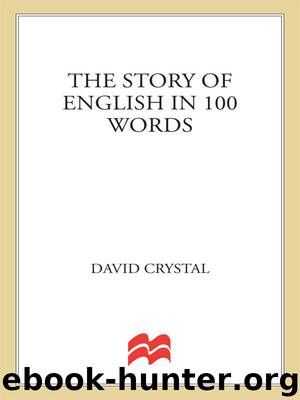The Story of English in 100 Words by Crystal David

Author:Crystal, David [Crystal, David]
Language: eng
Format: mobi, epub
Publisher: St. Martin's Press
Published: 2012-03-26T16:00:00+00:00
48
Lakh
A Word from India (17th century)
Here are two recent newspaper headlines from India.
Nearly 5 lakh foreigners throng India for cheap treatment
Rs 50-lakh divorce for runaway wife
Lakh. A Hindi word meaning 100,000. So, 5 lakh is half a million. 50 lakh (Rs = rupees) is 5 million. It’s one of the words you need to know. The figures get bigger when you turn to the business pages. There you find people talking about crores as well. A crore is 10 million.
These words arrived in English in the early 1600s. Already several Indian words had entered the language from earlier contacts. A godown is a place where goods are stored – a warehouse. It’s recorded in a voyager’s report of 1588. It comes from a Malay word, godong, and probably took its English form because people heard it as ‘go down’ – the store-houses were often in cellars.
Once the British East India Company was established (in 1600), travel to and from the region greatly increased. It wasn’t long before the local languages began to provide English with new words, and several eventually lost their cultural associations with India. From the north of the Indian subcontinent, where Indo-European languages such as Hindi were spoken, we find such 17th-century words as bungalow, dungaree, guru, juggernaut, punch (the drink) and pundit. Examples from the south, where Dravidian languages such as Tamil were spoken, were atoll, catamaran, cheroot, pariah, teak and curry. In the Far East, Tibetan, Malay, Chinese, Japanese and other languages all began to supply new words, such as ginseng, bamboo, ketchup, kimono, junk (the ship) and chaa – this last one not immediately recognisable in that form, but the origin of tea (and, of course, colloquial char).
The various routes to India also brought English into renewed contact with languages such as Arabic, Turkish and Persian. Quite a few Arabic words, for example, had come into Middle English, especially introducing scientific notions such as alchemy and almanac, but in the 16th and 17th centuries there is a significant expansion. In many cases, the Arabic words entered English through another language: assassin, for example, is ultimately from Arabic hash-shashin (‘hashish-eaters’), but came to English via Italian assassino.
The new words reflect local life and customs. Arabic loans include fakir, harem, jar, magazine, sherbet, minaret, alcove and sofa. From Turkish we find vizier, horde, kiosk, coffee and yoghurt. From Persian, bazaar, caravan, divan, shah and turban. From Hebrew, sanhedrin, shekel, shibboleth, torah and hallelujah.
Today, the regional English vocabulary of a country like India is extensive indeed, and continues to develop. The 20th century has seen a host of food words such as tandoori, samosa and pakora. Among the colloquial words to arrive have been cushy, doolally and loot (‘money’). A new lease of computational life has been given to avatar. And in Indian newspapers of the 2000s we will find such local forms as speed-money (‘bribe’), timepass (‘way of passing the time’), timewaste (‘time-wasting’) and petrol bunk (‘petrol station’), as well as new uses of older forms, such as hi-fi (‘fancy’, as in hi-fi clothes).
Download
The Story of English in 100 Words by Crystal David.epub
This site does not store any files on its server. We only index and link to content provided by other sites. Please contact the content providers to delete copyright contents if any and email us, we'll remove relevant links or contents immediately.
Cecilia; Or, Memoirs of an Heiress — Volume 1 by Fanny Burney(31369)
Cecilia; Or, Memoirs of an Heiress — Volume 3 by Fanny Burney(30965)
Cecilia; Or, Memoirs of an Heiress — Volume 2 by Fanny Burney(30921)
The Lost Art of Listening by Michael P. Nichols(6506)
We Need to Talk by Celeste Headlee(4901)
Asking the Right Questions: A Guide to Critical Thinking by M. Neil Browne & Stuart M. Keeley(4620)
On Writing A Memoir of the Craft by Stephen King(4245)
Dialogue by Robert McKee(3606)
I Have Something to Say: Mastering the Art of Public Speaking in an Age of Disconnection by John Bowe(3528)
Pre-Suasion: A Revolutionary Way to Influence and Persuade by Robert Cialdini(3440)
Elements of Style 2017 by Richard De A'Morelli(2952)
The Book of Human Emotions by Tiffany Watt Smith(2786)
Good Humor, Bad Taste: A Sociology of the Joke by Kuipers Giselinde(2567)
Name Book, The: Over 10,000 Names--Their Meanings, Origins, and Spiritual Significance by Astoria Dorothy(2505)
Fluent Forever: How to Learn Any Language Fast and Never Forget It by Gabriel Wyner(2468)
The Grammaring Guide to English Grammar with Exercises by Péter Simon(2407)
Why I Write by George Orwell(2376)
The Art Of Deception by Kevin Mitnick(2314)
Don't Sleep, There Are Snakes by Daniel L. Everett(2230)
